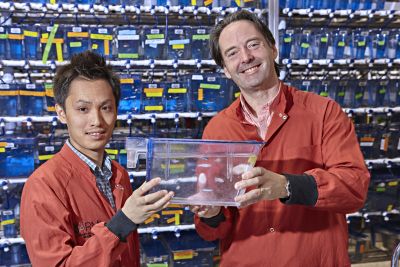Monash team wins Eureka Prize

It’s billed as the Oscars of Australian Science and last night Monash University researchers ARMI Deputy Director Professor Peter Currie and PhD student Phong Nguyen, from the Faculty of Medicine, Nursing and Health Sciences, together with Dr Georgina Hollway from the Garvan Institute of Medical Research have won this year’s Eureka Prize for scientific research.
The team of Melbourne and Sydney researchers has unlocked a mechanism that triggers stem cell production in blood, making the production of blood cells in the laboratory an achievable end goal.
Everyday medical procedures can require litres of donated blood. Could much of that blood be artificially created in the lab, reducing the pressure on blood banks?
For identifying a mechanism that triggers stem cell production in zebrafish blood, they have been awarded the University of New South Wales Eureka Prize for Scientific Research at an awards dinner in Sydney last night.
“These Australian researchers have transformed our understanding of stem-cell development,” Kim McKay AO, Executive Director and CEO of the Australian Museum said.
“Their work opens up a host of new research routes, with exciting potential to generate blood cells on demand for medical treatment,” she said.
The team identified a new family of cells – endotomal cells – that wrap themselves around nascent stem cells, signalling them via released proteins that it’s time to ‘switch on’.
The breakthrough is only the first step in what will be a lengthy scientific process, but it opens up a whole new line of inquiry within developmental biology: to find what other molecular signals are produced by these new cells to stimulate stem cell production.
“This work is complex but it’s vital that we communicate with the public about what is happening here. Being recognised at these prestigious awards will help us to achieve that,” Professor Currie said.
“We are thrilled to be awarded the years Eureka Prize for Scientific Research out of such a high quality field of scientist and testament to the hard work and dedication of our team of researchers.
“Our study has unravelled a mystery of stem cell generation by identifying for the first time mechanisms in the body that trigger hematopoietic stem cell (HSC) formation. HSCs are an amazing stem cell which makes all the different blood cell types in our body. The work takes us a step closer to developing a cure for a range of blood disorders and immune diseases.”
The ARMI researchers observed cells in the developing zebra fish – a tropical freshwater fish known for its regenerative abilities and optically clear embryos – to gather new information on the signalling process responsible for HSC generation.
Using high-resolution microscopy researchers made a film of how these stem cells form inside the embryo, which captured the process of their formation in dramatic detail.
When playing back these films they noticed that HSCs require a “buddy” cell type to help them form. These “buddies”, known as endotome cells, have stem cell inducing properties.
Phong Nguyen said endotome cells act like a comfy sofa for pre HSCs to snuggle into, helping them progress to become fully fledged stem cells.
“Not only did we identify some of the cells and signals required. The really exciting thing about these results is that if we can find the signals present in the endotome cells responsible for embryonic HSC formation then we can use them in vitro to make different blood cells on demand for all sorts of blood related disorder.”
Monash researchers behind groundbreaking research were also finalists in other categories:
- Professor Trevor Lithgow and Dr Hsin-Hui Shen, are part a research consortium shortlisted for the Australian Infectious Diseases Research Centre Eureka Prize for Infectious Diseases Research. Using nanoscale technology, their research uncovered secrets about the surface structures of antibiotic resistant bacteria that could potentially transform modern medicine and antibiotics.
- Shortlisted for the University of New South Wales Eureka Prize for Excellence in Interdisciplinary Scientific Research, was the EVestigators team led by Professors Jayashri Kulkarni and Brian Lithgow. In an industry alliance with Neural Diagnostics Pty Ltd, Lithgow’s EVestG invention has discovered for the first time that brainwave features recorded from the balance organ contain biomarker features that allow for an earlier, objective and more accurate diagnosis of mental and neurological conditions.
Established in 1827, the Australian Museum is the nation’s first museum and one of its foremost scientific research, educational and cultural institutions. The Australian Museum Eureka Prizes are the most comprehensive national science awards, honouring excellence in Research and Innovation, Leadership, Science Communication and Journalism, and School Science.
The team’s research can been viewed via video.
More information is available via Australian Museum.
